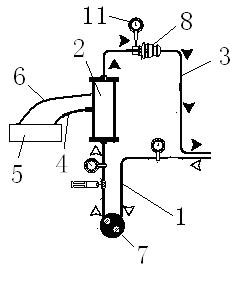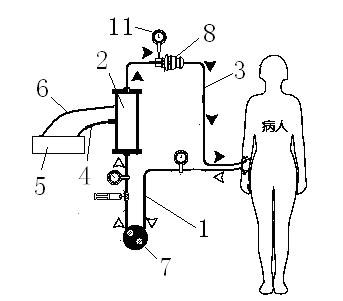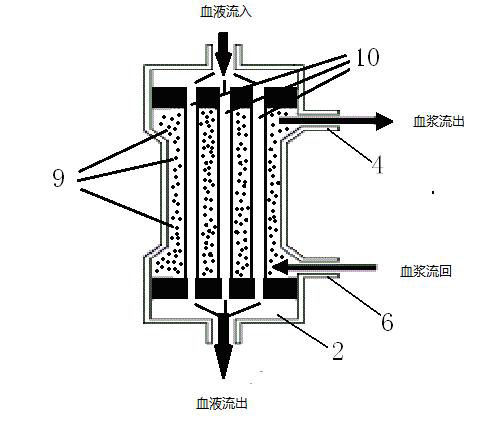Device and method for eliminating pathogens in blood
A pathogen and pathogen physics technology, applied in the field of medical devices, can solve problems such as large side effects, adverse reactions, and other substances brought into the patient's blood, and achieve the effects of convenient operation, reduced side effects, and simple device structure.
- Summary
- Abstract
- Description
- Claims
- Application Information
AI Technical Summary
Problems solved by technology
Method used
Image
Examples
Embodiment 1
[0029] Embodiment 1: Device embodiment
[0030] A device for removing pathogens from the blood, such as figure 1 As shown: it includes an extracorporeal circulation pathway composed of blood outflow tube 1, plasma separator 2 and blood return tube 3 connected in sequence, and also includes a pathogen physical inactivation device 5 connected to the extracorporeal circulation pathway. The specific connection method is: in the blood plasma A pathogen physical inactivation device 5 is connected to the plasma outflow pipe 4 and the plasma return pipe 6 of the separator 2 .
[0031] The connection method can also be: a pathogen physical inactivation device 5 is connected between the plasma outflow pipe 4 and the blood return pipe 3 or a pathogen physical inactivation device 5 is connected between the plasma outflow pipe 4 and the human body.
[0032] The pathogen physical inactivation device 5 includes an ultraviolet or microwave radiation device and a container, and the ultravio...
Embodiment 2
[0035] Embodiment 2: application embodiment
[0036] Such as figure 2 Shown, suffer from the patient's blood of AIDS to flow out from radial artery, it is passed through the plasma separator of embodiment 1 through blood pump action, and blood flow is 200ml / minute, and the plasma that is separated flows through a flat to ultraviolet transparent container ( For example, a quartz glass container with an internal volume of 10x10x1cm), the container is irradiated by an ultraviolet lamp with a wavelength of 253nm, and the irradiance intensity on the container is 60μW / cm 2 , the time for plasma to flow through the container is 30 seconds, and the entire operation lasts for 2 hours. It is then combined with blood cells and flowed back into the patient. After the above-mentioned intensity of ultraviolet radiation, more than 95% of HIV in the plasma sample can be inactivated through virus culture test.
[0037] The device can also be attached with an HIV adsorption device or a vi...
Embodiment 3
[0038] Embodiment 3: application embodiment
[0039] Such as image 3 As shown, the patient's blood (such as the blood of a patient with hepatitis B) flows into a hollow fiber plasma separator made of multiple polysulfone membranes. The total area of the membrane is 0.5 square meters, and the membrane pore size is 0.2-0.6 microns. Both ends of the container are connected with arterial and venous pipelines to allow blood to flow through the hollow fibers, and the hollow fibers are filled with solid-phase carrier pathogen adsorbents. The blood flow rate is 100ml / min, and there are hepatitis B virus affinity substances on the solid-phase carrier pathogen adsorbent, such as cross-linked dextran particles with a particle size of 0.5 mm that are covalently linked to anti-hepatitis B surface antigen antibodies. The plasma containing pathogens diffuses through the micropores on the membrane to the outside of the hollow fiber and contacts with the solid-phase carrier pathogen ads...
PUM
 Login to View More
Login to View More Abstract
Description
Claims
Application Information
 Login to View More
Login to View More - R&D
- Intellectual Property
- Life Sciences
- Materials
- Tech Scout
- Unparalleled Data Quality
- Higher Quality Content
- 60% Fewer Hallucinations
Browse by: Latest US Patents, China's latest patents, Technical Efficacy Thesaurus, Application Domain, Technology Topic, Popular Technical Reports.
© 2025 PatSnap. All rights reserved.Legal|Privacy policy|Modern Slavery Act Transparency Statement|Sitemap|About US| Contact US: help@patsnap.com



